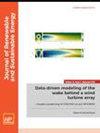基于帕尔森窗口估算法的风能和太阳能储能系统容量配置优化
IF 1.9
4区 工程技术
Q4 ENERGY & FUELS
引用次数: 0
摘要
压缩空气储能(CAES)可有效减少随机性导致的风能和太阳能电力削减。然而,不准确的日常数据和不恰当的储能配置影响了 CAES 的发展。本研究使用 Parzen 窗口估计法从历史数据中提取特征,获得典型的每周风力发电量、太阳能发电量和负荷的分布。这些分布与 Weibull 和 Beta 分布进行了比较。使用遗传算法优化风能-太阳能储能系统的容量配置,以实现利润最大化。在孤岛/并网模式下,使用评估指标对不同方法进行了比较,以验证 Parzen 窗口估算方法的准确性。结果表明,它超越了基于实时串联配置的参数估计。在并网模式下,风能的额定功率配置为 1107 兆瓦,太阳能为 346 兆瓦,CAES 为 290 兆瓦。CAES 系统的额定发电量为 2320 MW-h,可满足平均每小时 699.26 MW 的电力需求。每周可节省电费 655 万美元,每周最大利润 61 万美元。系统投资回收期为 5.6 年,不包括罚款费用。本文章由计算机程序翻译,如有差异,请以英文原文为准。
Optimization of wind and solar energy storage system capacity configuration based on the Parzen window estimation method
Compressed air energy storage (CAES) effectively reduces wind and solar power curtailment due to randomness. However, inaccurate daily data and improper storage capacity configuration impact CAES development. This study uses the Parzen window estimation method to extract features from historical data, obtaining distributions of typical weekly wind power, solar power, and load. These distributions are compared to Weibull and Beta distributions. The wind–solar energy storage system's capacity configuration is optimized using a genetic algorithm to maximize profit. Different methods are compared in island/grid-connected modes using evaluation metrics to verify the accuracy of the Parzen window estimation method. The results show that it surpasses parameter estimation for real-time series-based configuration. Under grid-connected mode, rated power configurations are 1107 MW for wind, 346 MW for solar, and 290 MW for CAES. The CAES system has a rated capacity of 2320 MW·h, meeting average hourly power demand of 699.26 MW. It saves $6.55 million per week in electricity costs, with a maximum weekly profit of $0.61 million. Payback period for system investment is 5.6 years, excluding penalty costs.
求助全文
通过发布文献求助,成功后即可免费获取论文全文。
去求助
来源期刊

Journal of Renewable and Sustainable Energy
ENERGY & FUELS-ENERGY & FUELS
CiteScore
4.30
自引率
12.00%
发文量
122
审稿时长
4.2 months
期刊介绍:
The Journal of Renewable and Sustainable Energy (JRSE) is an interdisciplinary, peer-reviewed journal covering all areas of renewable and sustainable energy relevant to the physical science and engineering communities. The interdisciplinary approach of the publication ensures that the editors draw from researchers worldwide in a diverse range of fields.
Topics covered include:
Renewable energy economics and policy
Renewable energy resource assessment
Solar energy: photovoltaics, solar thermal energy, solar energy for fuels
Wind energy: wind farms, rotors and blades, on- and offshore wind conditions, aerodynamics, fluid dynamics
Bioenergy: biofuels, biomass conversion, artificial photosynthesis
Distributed energy generation: rooftop PV, distributed fuel cells, distributed wind, micro-hydrogen power generation
Power distribution & systems modeling: power electronics and controls, smart grid
Energy efficient buildings: smart windows, PV, wind, power management
Energy conversion: flexoelectric, piezoelectric, thermoelectric, other technologies
Energy storage: batteries, supercapacitors, hydrogen storage, other fuels
Fuel cells: proton exchange membrane cells, solid oxide cells, hybrid fuel cells, other
Marine and hydroelectric energy: dams, tides, waves, other
Transportation: alternative vehicle technologies, plug-in technologies, other
Geothermal energy
 求助内容:
求助内容: 应助结果提醒方式:
应助结果提醒方式:


